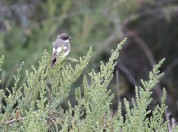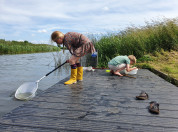Zoeken
Filteren op
Type
Labels
Dossiers
Thema's
Afdelingen
Taal
Active filters
1730 zoekresultaten
Zoekresultaten
-
Accessibility
Toegankelijkheid op de NIOO website -
Toegankelijkheid
Toegankelijkheid op de NIOO website -
NIOO Theme Sustainable use of land and water
Healthy surface water and soils are essential for life on earth. They provide a range of life-supporting functions, including carbon storage, oxygen generation, and nutrient cycling. At NIOO, we combine research on the ecosystem services provided to society with research on how these ecosystem services are impacted by society.
-
Privacy statement
Privacy statement -
Netherlands Long-term Ecosystem Research Network (LTER-NL)
The Netherlands has a strong tradition in long-term ecological research, with for instance internationally renowned population studies on tits started in the 1950s by the NIOO, population studies on benthic animals started in the 1970s by the NIOZ and citizen science bird monitoring started by Sovon Dutch Centre for Field Ornithology started in the 1970s. It was however not until 2010 that LTER-NL, the Dutch network for Long-term Ecosystem Research, was developed from scratch, with
WaLTER
(external link)
(Wadden Sea Long-Term Ecological Research) as the starting point. In 2014 LTER-NL, consisting of only the LTSER-platform Dutch Wadden Sea, was provisionally admitted to the international umbrella organizations
ILTER
(external link)
and
LTER-Europe
(external link)
. In 2015, the Veluwe LTSER platform was added along with the Belgium listed LTSER-platform Scheldt Estuary, which includes the Dutch Westerschelde. In 2016 LTER-Netherlands was unconditionally admitted to ILTER and LTER-Europe. -
Netherlands Long-term Ecosystem Research Network (LTER-NL)
Nederland heeft een sterke traditie op het gebied van lange termijn ecologisch onderzoek, waaronder internationaal vermaarde populatieonderzoek aan mezen dat in de jaren vijftig van de vorige eeuw werd gestart door het NIOO, populatieonderzoek aan bodemdieren, dat in de jaren zeventig werd gestart door het NIOZ en burgerwetenschappelijke vogelmonitoring dat in de jaren zeventig werd gestart door Sovon Vogelonderzoek Nederland. Het duurde echter tot 2010 voordat LTER-NL, het Nederlandse netwerk voor Langetermijn Ecosysteemonderzoek tot stand kwam. -
Ecofactsheets van Dierecologie
Factsheets van de afdeling Dierecologie van het NIOO-KNAW
-
Dierecologie in de media
De afdeling Dierecologie van het NIOO-KNAW is regelmatig in de media te vinden.
-
NIOO Thema Klimaatverandering
Als we de opwarming van de aarde niet beperken zijn de gevolgen onomkeerbaar. Hoeveel veerkracht heeft de natuur? Hoe goed passen soorten zich aan? En hoe kan de natuur helpen om de klimaatproblemen te verminderen?
-
Citizen Science at NIOO
'Community' science has been gaining momentum in recent years. At NIOO, we've always valued the contributions of citizen scientists. In fact, our oldest citizen science project goes back more than a century.
